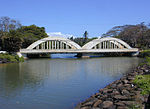Haleiwa Fighter Strip
Airfields of the United States Army Air Forces in HawaiiAttack on Pearl HarborBuildings and structures in Honolulu County, HawaiiDefunct airports in HawaiiHistory of Oahu

Haleiwa Fighter Strip was a military airfield on Oahu, Hawaii. It was used as part of the island's defense in World War II.
Excerpt from the Wikipedia article Haleiwa Fighter Strip (License: CC BY-SA 3.0, Authors, Images).Haleiwa Fighter Strip
Kahalewai Place,
Geographical coordinates (GPS) Address Nearby Places Show on map
Geographical coordinates (GPS)
| Latitude | Longitude |
|---|---|
| N 21.604444444444 ° | E -158.10222222222 ° |
Address
Haleiwa Airstrip
Kahalewai Place
96712
Hawaii, United States
Open on Google Maps








